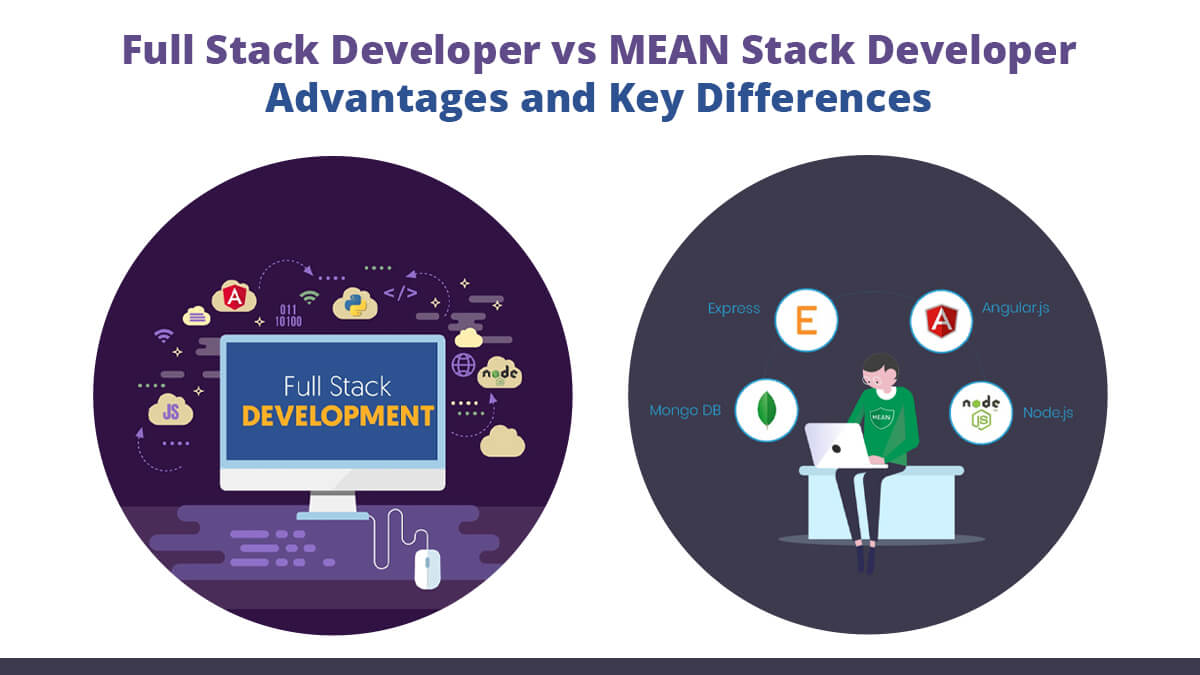The destinations you see on the web have various sides. The first is the one you see, and the other one works far out to manage the data of the same. The past is called front-end progression, and it contains the site arrangement and its interface. The last is known as back-end advancement, and it manages information bases and worker side programming. To run a site ideally, you’ll have to put resources into both of these areas.

A site won’t look extraordinary if it doesn’t have legitimate front-end improvement. Also, it wouldn’t have the option to handle its information if it needs sufficient back-end improvement. Both of these areas are very unpredictable. The innovation stack is intended for the product improvement measure where an application stack is a bunch of useful programs that help in playing out a specific undertaking. The stack helps in growing ongoing programming while at the same time disregarding the lattices confronted when designers use independent innovations.
Full-stack alludes to a gathering of programming dialects and apparatuses a designer figures out how to deal with both the front-end and back-end advancement of a site. MEAN stack, then again, is a mainstream full-stack structure, which comprises MongoDB, Express.js, AngularJS, and NodeJS. Full-stack isn’t confined to a specific arrangement of dialects, while structures like MEAN stack is limited. As a full-stack engineer, you should get familiar with various dialects identified with web advancement alongside a couple of ideas of website architecture also. Full-stack alludes to the designer, though MEAN stack is an abbreviation for a full-stack system. The two of them are broadly mainstream. What’s more, the interest of full-stack designers is high. Nonetheless, there are a lot of territories where these two variables.
Front-End Development
The MEAN stack contains numerous choices that make it appropriate for vigorous front-end improvement. AngularJS is a front-end structure, and it empowers engineers to utilize HTML punctuation and express different segments without hardly lifting a finger. It underpins two-way information authoritative and empowers model view regulator structural examples for the advancement of enormous web applications.
Cutting edge sites require responsive plans. Not exclusively does a dependable plan help in keeping the code basic, however, it additionally upgrades the client experience as the site effectively adjusts to various gadgets. Both full-stack and MEAN stack have different highlights and advancements that empower simple front-end improvement. Numerous engineers incline toward the MEAN stack for front-end improvement because of AngularJS. In the two cases, engineers need to utilize HTML5, CSS3, and JavaScript as essentials.
Back-End Development
MEAN stack likewise empowers the designer to utilize NodeJS for worker side programming. Aside from NodeJS, Express.js additionally helps in such a manner by rearranging back-end advancement. NodeJS lets you use JavaScript for worker side programming. It establishes a climate where you can utilize JavaScript code on the worker. NodeJS additionally underpins offbeat programming, which is the reason it’s a favored decision of numerous designers.
Notwithstanding, JavaScript doesn’t have numerous highlights that help it in worker side programming. It’s very restricted, and even with NodeJS and Express.js, it can’t offer as amazing outcomes as well known worker side dialects, for example, PHP and Python. That is the reason full-stack engineers have high ground for this situation. They know about regular worker side dialects which causes them in back-end improvement. MEAN stack engineers can’t exploit C#, C++, PHP, and different dialects.
Systems
MEAN stack engineers likewise approach different systems that quicken the different cycles identified with site creation and the executives. They can effectively perform front-end web advancement by utilizing the improved speed of the AngularJS system. Since they learn JavaScript, they likewise have the alternative to utilize other customer-side web systems, for example, ReactJS. For back-end advancement, they can utilize Express.js and NodeJS. These systems are unequivocally made for front-end and back-end improvement. Notwithstanding, MEAN stack engineers are restricted to these choices as they don’t know the different structures and devices that are available.
Full-stack designers, then again, know a wide range of systems, which they can use as they esteem right. They have more opportunities in such a manner. Aside from systems, there’s a major distinction between the two with regards to information bases also. A MEAN stack engineer depends on MongoDB in such a manner. MongoDB is a famous decision among current web engineers since it is simpler to scale information with it. MongoDB is a non-social, open-source, NoSQL information base that centers around report based capacity of information. Full-stack engineers approach numerous other SQL-based and social information bases. Along these lines, they have more alternatives to look over, and they can rapidly deal with an assortment of activities.
Similitudes Between Full Stack and MEAN Stack
Since we have rattled off the contrasts between the two we should begin examining the likenesses. The two of them make an individual a full-stack designer. In the wake of adapting both of those, you can without much of a stretch handle the customer side just as worker side activities. Full-stack improvement expects you to become familiar with numerous programming dialects that cover front-end and back-end advancement, while, MEAN stack improvement expects you to get acquainted with different structures for a similar reason.
The interest in both of these specialized topics is high. While MEAN stack engineers normally have a superior hold on JavaScript related tasks, full-stack designers have more information. Subsequently, the vast majority of the organizations profit by employing the two of them. MEAN stack is a part of full-stack. In this way, in case you’re trying to turn into a full-stack designer, you should become familiar with the MEAN stack also.
Full Stack Developer Responsibilities:
- Developing front end site design.
- Designing client collaborations on pages.
- Developing back-end site applications.
- Creating workers and information bases for usefulness.
- Ensuring cross-stage advancement for cell phones.
- Ensuring the responsiveness of uses.
- Working close by visual creators for website architecture highlights.
- Seeing through an errand from the start to the completed item.
- Designing and creating APIs.
- Meeting both specialized and buyer needs.
- Remaining next to each other of upgrades in web applications and programming tongues.
Full Stack Developer Requirements:
- Degree in Computer Science.
- Strong hierarchical and venture the board aptitudes.
- Proficiency in focal front end tongues, for instance, HTML, CSS, and JavaScript.
- Familiarity with JavaScript frameworks, for instance, Angular JS, React, and Amber.
- Proficiency in laborer side lingos, for instance, Python, Ruby, Java, PHP, and .Net.
- Familiarity with database development, for instance, MySQL, Oracle, and MongoDB.
- Excellent verbal social capacities. Incredible basic reasoning capacities. Carefulness.
Mean Stack Architect Commitments:
- Hands-on Experience and manage Node js, Mongo DB, Angular js, and Express js
- Planner, Develop, test, and send healthy things that are snappy, adaptable, and significantly responsive
- Plan and keep up gigantic and complex databases, both social and non-social informational indexes
- Build up, refine and organize progression condition devices and programming differing
- Recognize creation and non-creation application issues as a part of the association
- Convey applications on AWS cloud with the ability to quickly investigate encouraging related issues
Mean Stack Developer Necessities
- Ability to contribute exclusively
- Proficiency in Complete Mean, Node js, MongoDB, Angular js, and Express js
- Expertise in PHP, jQuery, MySQL, Symfony, OOPS
- Experience in worker the board and AWS information is important
- Ability to administer and lead a gathering of architects
- Strong logical and critical thinking aptitudes
- Immediate joiners are valued
- Best in industry compensation
Contrasts Between the Two in Innovative Transformation for the Diverse Cycle:
1. Customer Side Technologies
Normally website specialists will utilize responsive website architecture for creating sites that help numerous gadgets like a work area, tablets, and cell phones with a solitary codebase. Thusly, for making responsive site models, any fashioners need to gather an interface using HTML, CSS, and JavaScript.
Both MEAN and Full-stack permit designers to utilize HTML, CSS, and JavaScript to assemble an interface for an application. Further in MEAN stack designers are broadly encouraged to utilize Angular as a front-end improvement system.
2. Worker Side Technologies
In MEAN, node.js has enabled fashioners to form laborer side code in JavaScript. That is in MEAN Stack engineers can code workers just as customer-side code in JavaScript. Even though JavaScript still doesn’t have a segment of the lively features which are given by other specialist side programming tongues.
Full-stack engages planners to exploit any of the ground-breaking specialist side programming tongues like Java, Python, PHP, Ruby, and C#.
3. Information Bases
As expressed above in MEAN Stack, there is just a solitary information base — Mongo DB. As you probably are aware Mongo DB is one of the non-social information bases which doesn’t store records in tables rather it makes archives for each record. Because of its versatility and security, it gives over social information bases web engineers these days incline toward MongoDB. In Full-stack web advancement, designers are permitted to work with a variety of social and non-social information bases like MySQL, SQL Server, Oracle, PostgreSQL, and SQLite.
4. Web Frameworks
The MEAN stack contains both frontend and backend web structures. Anyone can without a very remarkable stretch learn client-side web improvement by using Angular.js and laborer side progression by using Node.js and Express.js.
The full-stack improvement approach empowers designers to work with fluctuated frontend and backend web systems. You can browse a wide scope of full-stack web structures as indicated by their decision of programming language and exact undertaking needs.
Favorable Circumstances of a MEAN Stack Developer
Concerning MEAN stack progression, you will experience the going with ideal conditions:
- MEAN stack improvement grants you to create sites/applications quicker and less difficult because engineers need to code both the frontend and backend perspectives just a single time in JavaScript.
- If your MEAN stack engineer has composed code in one structure, you can without much of a stretch exchange or move the code to an alternate system with MEAN stack.
- Once you’re finished with the advancement of your site or application, the MEAN stack makes it simpler for you to test the yield on the cloud.
- Similar to full-stack improvement, MEAN stack is moreover monetarily smart basically because of the lesser need of planners and the openness of open-source gadgets and structures.
- MEAN stack additionally makes ongoing item shows less difficult.
Preferences of a Full Stack Developer
Full-stack advancement has its exceptional arrangement of points of interest to your ventures like the accompanying.
- In this present, it’s simpler for a full-stack engineer to switch among backend and frontend advancement relying upon your venture necessities.
- Full-stack advancement doesn’t confine your engineer to only one specific arrangement of structures or improvement viewpoints. You can utilize a full-stack designer to play out an assortment of assignments from web advancement to configuration organizing and that’s only the tip of the iceberg.
- Full-stack improvement is very savvy as you have one super-particular asset as opposed to recruiting unmistakable engineers for frontend and backend advancement.
- In this, a full-stack engineer can consistently assume responsibility for the total plan and the usage cycles of your task.
- Full-stack designers discover it nearly simpler to move up to the most recent devices and patterns in their specialty.
- This is ideal for little to medium-sized organizations.
End
In the full-stack web, advancement ventures can get the frontend and backend of the site created with similar engineers. MEAN stack energizes full-stack progression by creating both client-side and specialist side code in JavaScript. Then, the MEAN stack doesn’t use an incredible specialist side programming language, and where the full-stack web improvement framework uses a generous laborer side programming language. We offer both Full-stack and MEAN stack improvement to assemble a successful web application. You can enroll full-stack planners who are authorities in working up a responsive web application.
